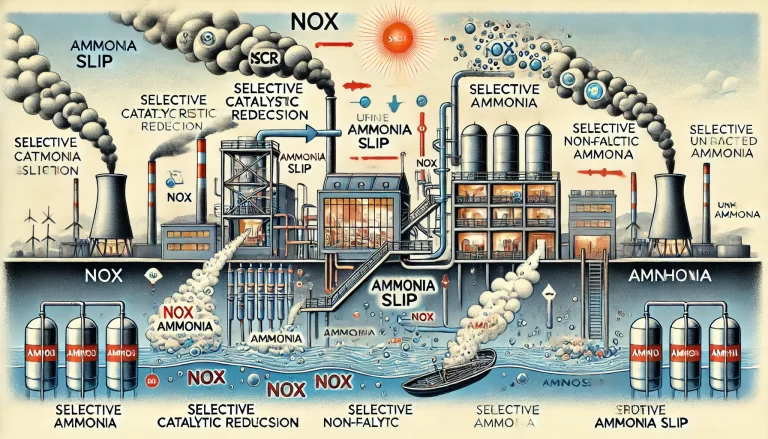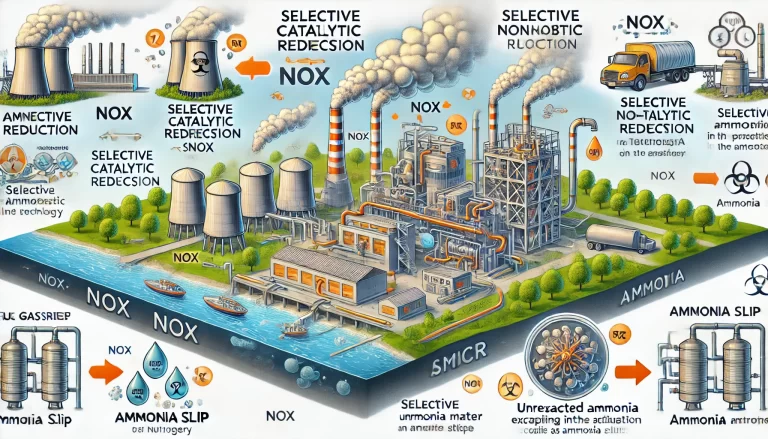1. What is Ammonia Slip?
Ammonia slip refers to the phenomenon where ammonia, used as a reducing agent in industrial denitrification processes, escapes into the atmosphere without fully reacting. Denitrification technologies such as Selective Catalytic Reduction (SCR) and Selective Non-Catalytic Reduction (SNCR) are employed to reduce nitrogen oxides (NOx) emissions by converting them into nitrogen (N2) and water (H2O) using ammonia or urea. However, due to various operational and system design factors, some ammonia fails to react with NOx and is emitted into the atmosphere as ammonia slip.
2. Causes of Ammonia Slip
2.1 Inefficient System Design
Non-Uniform Ammonia Distribution: An uneven distribution of ammonia in the flue gas stream can lead to localized regions with excessive ammonia concentration while other areas remain deficient. This imbalance results in incomplete reactions and increased ammonia slip.
Catalyst Issues: Inappropriate selection of catalysts or the degradation of catalyst performance due to aging or fouling reduces the efficiency of the denitrification process, contributing to higher ammonia slip levels.
2.2 Poor Operational Parameters
Excessive Ammonia Injection: When the molar ratio of ammonia to NOx exceeds the stoichiometric requirement, surplus ammonia escapes unreacted.
Suboptimal Temperature: The SCR and SNCR processes operate efficiently within a specific temperature range. Deviations from this range, whether too high or too low, adversely affect the reaction efficiency and increase ammonia slip.
2.3 Equipment Failures and Maintenance Issues
Faulty Injection Systems: Malfunctioning ammonia injection valves or inaccurate flow meters can result in uncontrolled ammonia dosing.
Catalyst Blockage or Wear: Accumulation of ash, particulate matter, or chemical fouling can impair catalyst functionality, reducing reaction efficiency and increasing slip.

3. Impacts of Ammonia Slip
3.1 Environmental Pollution
Secondary Particulate Formation: Ammonia in the atmosphere reacts with sulfur dioxide (SO2) and NOx to form secondary particulates such as ammonium sulfate and ammonium nitrate. These fine particles contribute significantly to air pollution and haze, posing serious risks to human health and environmental quality.
3.2 Health Risks
Irritation and Toxicity: Ammonia is a pungent gas that irritates the eyes and respiratory system. Prolonged exposure to high concentrations may cause severe health issues, including chemical burns and systemic toxicity.
3.3 Equipment Damage
Corrosion and Fouling: Ammonia reacts with sulfur trioxide (SO3) in flue gas to form ammonium bisulfate, a highly sticky and corrosive compound. This can deposit on heat exchangers, air preheaters, and other equipment, leading to corrosion, blockages, and reduced operational efficiency.
3.4 Increased Operational Costs
Higher Maintenance Requirements: Addressing ammonia slip often involves additional system adjustments, increased catalyst replacement frequency, and intensive equipment maintenance.
Ammonia Wastage: Unutilized ammonia represents a direct waste of reagents, inflating operational expenses.
4. Mitigation Strategies for Ammonia Slip
4.1 Optimized System Design
Uniform Ammonia Distribution: Employ advanced ammonia injection systems such as zoned or dynamic distribution grids to ensure even dispersion across the flue gas stream.
Catalyst Selection: Choose catalysts tailored to the specific flue gas composition and operating conditions, with high catalytic activity and resistance to poisoning or fouling.
4.2 Precise Operational Control
Accurate Ammonia-to-NOx Ratio: Implement real-time monitoring and control systems to maintain the optimal molar ratio of ammonia to NOx, preventing over-injection.
Temperature Management: Utilize technologies such as flue gas reheating to maintain the ideal reaction temperature, enhancing the reaction efficiency.
4.3 Enhanced Maintenance Practices
Regular Equipment Inspection: Conduct periodic checks and calibration of critical components like injection valves and flow meters to ensure accurate performance.
Catalyst Regeneration: Schedule routine cleaning and regeneration of catalysts to restore their activity and prolong their lifespan.
Anti-Corrosion Measures: Apply protective coatings and materials to mitigate the corrosive effects of ammonium bisulfate deposits.
4.4 Continuous Monitoring
Ammonia Slip Monitors: Install advanced ammonia slip detection systems at the outlet of denitrification units to provide real-time data on ammonia concentrations. Technologies such as tunable diode laser absorption spectroscopy (TDLAS) can enable prompt adjustments to operating parameters.

5. Ammonia Slip Measurement Techniques
5.1 Chemical Absorption Method
Principle: This method involves capturing ammonia in a specific chemical absorbent (e.g., diluted sulfuric acid) and analyzing the resulting ammonium compound through titration or other chemical analysis techniques.
Advantages: High accuracy and reliability.
Limitations: Labor-intensive and unsuitable for real-time monitoring.
5.2 Tunable Diode Laser Absorption Spectroscopy (TDLAS)
Principle: TDLAS measures ammonia concentration by analyzing the absorption of a specific wavelength of laser light as it passes through the flue gas.
Advantages: Real-time, non-intrusive, and highly sensitive.
Limitations: High equipment cost and susceptibility to dust and fouling.
5.3 Fourier Transform Infrared Spectroscopy (FTIR)
Principle: FTIR measures the infrared absorption spectrum of gases to identify ammonia and other components. By analyzing the characteristic peaks of ammonia, its concentration can be determined.
Advantages: Simultaneous measurement of multiple gas species with high precision.
Limitations: Expensive equipment and complex maintenance requirements.
Conclusion
Ammonia slip is a significant challenge in industrial emission control, with implications for environmental quality, human health, and operational costs. Understanding its causes and adopting targeted mitigation strategies can significantly reduce its occurrence. By leveraging advanced technologies, optimizing system designs, and implementing robust maintenance practices, industries can minimize ammonia slip, ensuring compliance with stringent environmental regulations while reducing operational inefficiencies.
